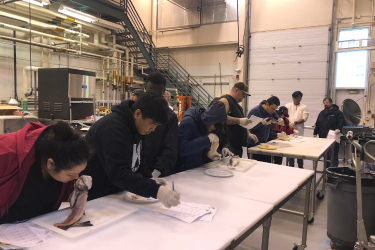Sea turtles have complex lives. Hatchlings go from nesting beaches into offshore waters where they may live for several years. Then juvenile turtles move to nearshore feeding grounds, where they may remain for decades until they reach sexual maturity. Then they migrate, sometimes thousands of miles, back to the area of their original nesting beach. This broad scope presents challenges for collecting comprehensive biological and ecological data. At the same time, the absence of such information complicates evaluation of management strategies for populations at risk of extinction.
For example, hawksbill sea turtles are endangered worldwide, primarily due to long-term harvest in some foreign countries. Sea turtles are harvested for food and their shells are used for jewelry and hair combs. However, available information regarding life stage durations, growth patterns, and maturation gives scientists a better understanding of human impacts and potential for recovery.
To help protect threatened and endangered sea turtle populations, we need to collect a lot of information to understand what might be putting them at risk. This includes answering questions such as: How long does it take a tiny sea turtle hatchling to become a large adult? How long do turtles spend in different habitats as they are growing up? But sea turtles are highly migratory, and spend most of their time underwater. They do not have features on the outsides of their bodies that give consistent clues as to their age. So answering these questions can be somewhat challenging.
Instead of being able to collect the information through direct observation, scientists often find themselves in the roles of “biological detectives.” They figure out ways to get the answers we need indirectly, including trying to figure out mysteries of age and habitat use.
One approach to studying these questions involves analyzing marks in the bones of sea turtles that wash ashore dead (strand), that are similar to tree rings. Collaborating with the National Sea Turtle Stranding and Salvage Network,we have collected bones from stranded turtles over large areas and long periods of time. We cut cross-sections of bone and conduct a type of laboratory tissue processing called histology to highlight the marks. This makes the marks easier to count and measure.
Research has shown that typically one mark is formed each year. This means that it is possible to assign an age and a calendar year for each mark in a bone. Biologists have also found that there is a very close relationship between measurements of bone marks with sea turtle shell length. This means that we can also estimate body size associated with each mark that can be measured within a bone section. Taking that a step further, we can also look at the difference between sequential body size estimates to calculate how much a turtle grew each year.
Additionally, scientists can examine the chemical composition of bone layers between marks that indicates where turtles have been living and what they have been eating. This can then be related back to age, size, growth, and calendar year. Taken together, all of this information can be very helpful when looking at trends in age, growth, and habitat use over broad areas and long periods of time.
Using this approach, researchers have found regional differences in growth patterns. They have started to evaluate whether this might be due to environmental changes and/or variability in preferred prey.


